英语考试作文-9分雅思图表写作范文全集之流程图 砖块制造流程
雅思作文流程图地图题范文.doc

雅思作文流程图地图题范文小作文大多为图表类作文,下面是的雅思流程图作文和地图作文,希望能帮到大家!There are four main stages in the production of plastic paper clips from this small factory. Two of these stages involve actual preparation of the clips, while the other two consist of quality control before the clips are sent out from the factory to the retailers to be sold to the public.To begin with, molten plastic is poured into three different moulds depending on the colour required; the colours are red, blue and yellow. Once these clips emerge from the moulds a quality control machine checks them for strength. Unsatisfactory clips are rejected. In the third stage in the process the clips are stored by hand into two groups, mixed and single colours. When this stage is plete the groups are checked a second time to ensure that the colour mixtures are divided correctly into single colours and mixed colour batches. Finally, the clips are packed and dispatched to the markets.The diagram shows the stages in the processof making chocolate Chocolate es from the cacao tree, which is grown in parts of South America, Africa and Indonesia.The tree produces large red pods which contain white cocoa beans. Firstly,when the pods are ripe,they are harvested,the beans are removed and they are fermented for several days in large wooden boxesDuring the fermenting process, the beans turn brown.Next, the brown beans are spread in the sun to dry. They are then put in large sacksand transported by train or lorry. After this, the beans are taken to a chocolate factory where they are roasted in an oven at temperatures of between 250 and 350 degree Celsius.After being roasted, the beans are crushed and the outer shell is removed. This part is not needed for making chocolate. Finally, the inner part of the bean is pressed and liquid chocolate is produced.The map shows the growth of a village called Chorleywood between 1868 and 1994.It is clear that the village grew as the transport infrastructure was improved. Four periods of development are shown on the map, and each of the populated areas is near to the main roads, the railway or the motorway.From 1868 to 1883, Chorleywood covered a small area next to one of the main roads. Chorleywood Park and Golf Course is now located next to this original village area. The village grew along the main road to the south between 1883 and 1922, and in 1909 a railway line was built crossing this area from west to east. Chorleywood station is in this part of the village.The expansion of Chorleywood continued to the east and west alongside the railway line until 1970. At that time, a motorway was built to the east of the village, and from 1970 to 1994, further development of the village took place around motorway intersections with the railway and one of the main roads.。
雅思小作文流程图类题目范文及解析

雅思小作文流程图类题目范文及解析雅思小作文流程图类题目范文及解析,一起来学习一下吧,下面我就和大家共享,来观赏一下吧。
雅思小作文流程图类题目范文及解析雅思小作文流程图类题目范文及解析为大家带来雅思小作文当中一类较有难度的图表——流程图类的小作文的范文以及解析。
流程图顾名思义就是对某一有时间和步骤先后挨次的行为进行步骤的拆解,并配上相应的文字和解说而生成的图表。
我们在处理流程图类图表作文是应当怎么写,请看下文。
上图来自网络主题:家居设计题型:流程图The diagrams below show some principles of house design for cool and for warm climates.满分范文:The diagrams show how house designs differ according to climate.这些图表显示房子的设计因气候而不同。
The most noticeable difference between houses designed for cool and warm climates is in the shape of the roof. The designs also differ with regard to the windows and the use of insulation.为凉快和暖和气候设计的房子之间最明显的区分是屋顶的外形。
在窗户和保温材料的使用方面,设计也有所不同。
We can see that the cool climate house has a high-angled roof, which allows sunlight to enter through the window. By contrast, the roof of the warm climate house has a peak in the middle and roof overhangs to shade the windows. Insulation and thermal building materials are used in cool climates to reduce heat loss, whereas insulation and reflective materials are used to keep the heat out in warm climates.我们可以看到凉快的气候房子有一个高角度的屋顶,它允许阳光通过窗户进入。
雅思小作文流程图范文

雅思小作文流程图范文以下是一篇关于流程图的雅思小作文范文,字数为700字:The flowchart illustrates the process of making instant noodles. It is evident that there are six main steps in this process.To begin with, the production starts with the mixing of flour, water, and other necessary ingredients. After that, the dough is kneaded into a flat sheet, and then it is rolled by a machine until it is thin enough to be cut into noodles. In the next step, the noodles are steamed to remove any remaining moisture and make them more flexible.The noodles are then divided into small portions, and they are stretched with the help of machine-made negative pressure. Subsequently, these noodles are put into a boiling pot for a few minutes until they are cooked and ready to eat. Finally, they are quickly dried to extend their shelf life, and then they are packed in plastic packets and delivered to customers.Overall, the process of making instant noodles is quite simple. It involves mixing the ingredients, kneading and cutting the dough, steaming, stretching, boiling, drying, and packaging the noodles.In conclusion, the flowchart clearly demonstrates the process of making instant noodles. It can be seen that there are six main steps involved, from mixing the ingredients to packaging the final product.。
英语雅思流程图范文

英语雅思流程图范文Title: The Production Process of a Mobile Phone.The diagram illustrates the production process of a mobile phone, which begins with the concept stage and ends with the final assembly and testing. This entire processcan be divided into several key stages, each with its ownset of steps.The first stage is Research and Development (R&D),where the concept of the phone is born. Engineers and designers work together to create a prototype based on market research and consumer demand. This prototype is then tested for functionality, durability, and user-friendliness. Once the prototype meets the required standards, it moveson to the next stage.The second stage is Component Manufacturing. Here, various components such as the screen, battery, camera, and chipset are produced. Each component goes through its ownproduction process, which involves raw material procurement, processing, and quality control. For example, the screen is manufactured using special glass and coated with various layers to enhance visibility and touch sensitivity. The chipset, which is the brain of the phone, is produced using advanced semiconductor technology.The third stage is Assembly. In this stage, all the components are brought together and assembled into a complete phone. This process is highly automated and precise, as each component needs to be placed in the exact right position. The assembly line is equipped with robots and sensors to ensure accuracy and efficiency.Once the phone is assembled, it moves on to the next stage, which is Testing. Here, the phones are put through a series of rigorous tests to ensure they meet the required standards. These tests include functional testing,durability testing, and compatibility testing. Only phones that pass all the tests are considered ready for sale.The final stage is Packaging and Shipping. In thisstage, the phones are packaged in boxes or protectivecovers and shipped to distribution centers around the world. The packaging is designed to protect the phones duringtransit and ensure they arrive in perfect condition.Throughout the entire production process, qualitycontrol is a constant factor. At each stage, quality inspectors check the products to ensure they meet the required standards. This ensures that only the best quality phones reach the consumer.In conclusion, the production of a mobile phone is a complex process that involves multiple stages and steps. It requires meticulous planning and execution to ensure that each phone is produced to the highest standards. Thediagram illustrates this process clearly, showing the flow from concept to final product.。
雅思写作小作文范文 雅思写作流程图flow chart 消费品制造过程.doc
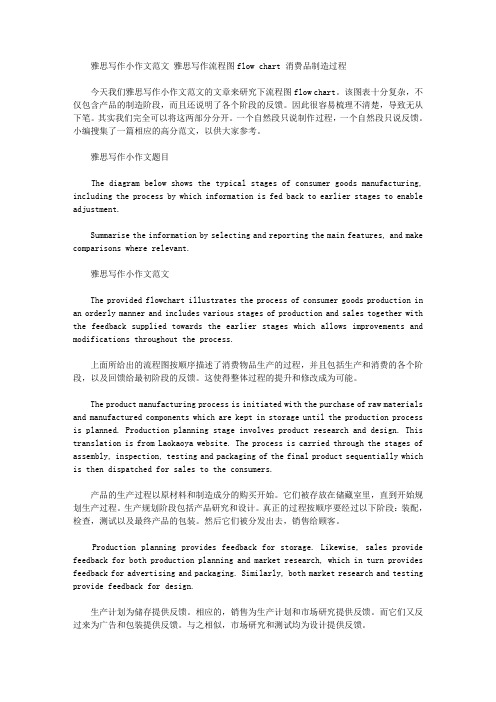
雅思写作小作文范文雅思写作流程图flow chart 消费品制造过程今天我们雅思写作小作文范文的文章来研究下流程图flow chart。
该图表十分复杂,不仅包含产品的制造阶段,而且还说明了各个阶段的反馈。
因此很容易梳理不清楚,导致无从下笔。
其实我们完全可以将这两部分分开。
一个自然段只说制作过程,一个自然段只说反馈。
小编搜集了一篇相应的高分范文,以供大家参考。
雅思写作小作文题目The diagram below shows the typical stages of consumer goods manufacturing, including the process by which information is fed back to earlier stages to enable adjustment.Summarise the information by selecting and reporting the main features, and make comparisons where relevant.雅思写作小作文范文The provided flowchart illustrates the process of consumer goods production in an orderly manner and includes various stages of production and sales together with the feedback supplied towards the earlier stages which allows improvements and modifications throughout the process.上面所给出的流程图按顺序描述了消费物品生产的过程,并且包括生产和消费的各个阶段,以及回馈给最初阶段的反馈。
这使得整体过程的提升和修改成为可能。
雅思小作文-流程图
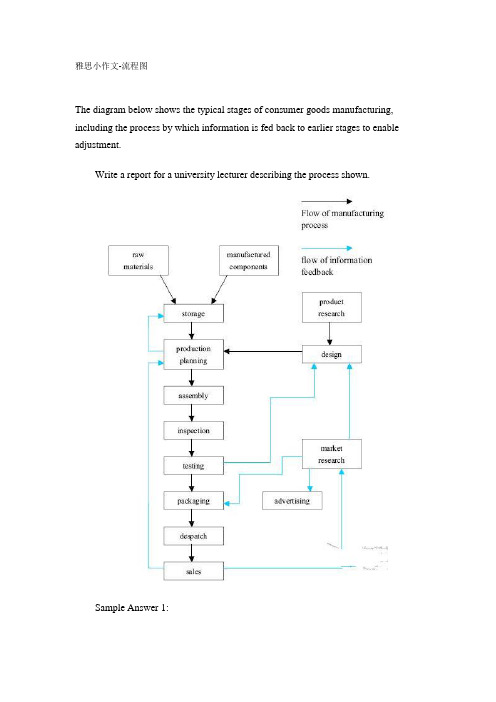
雅思小作文-流程图The diagram below shows the typical stages of consumer goods manufacturing, including the process by which information is fed back to earlier stages to enable adjustment.Write a report for a university lecturer describing the process shown.Sample Answer 1:The given diagram shows the stages of manufacturing and process adjustment of the consumer goods. As is observed from the flow chart, the goods manufacturing is a complex process which is done in several stages and information is sometimes fed back to earlier stages to make some adjustments.Firstly, raw materials and other components are stored together and production planning is done. There are two major process involves in the overall manufacturing process: one is manufacturing process itself and another one is the information feedback process with which the adjustment of the manufacturing is done. After the product research, the design part is done and this input is used in product planning stage. After the production planning is complete the assembly, inspection, testing and packaging stages are done sequentially. Feedback from testing phase is used in design stage and which led back to product planning stage. Again, the market research affects the design and advertising stages and inputs from the market research stage is used in packaging stage. The final two stages are dispatch and sales. The information flow stages gives feedback to other stages to refine and adjust the process.In summary, the consumer goods manufacturing process involves both themulti-staged manufacturing and research methods. The manufacturing stages involve the storage, assembly, inspection, packing to the sales methods whereas the research stages include market & product research, design and advertisement.(Approximately 231 words)Sample Answer 2:The given diagram shows the steps of consumer products manufacturing process, as is clearly show in the diagram that goods manufacturing is a complex process from collection of raw materials to the end product.As the process clearly shows the first stage of product development is collection and storage of raw materials and manufacturing components. The second stage is designing of the products and production planning and it’s a lengthy process which includes supervision and monitoring designing progress frequently, and before marketsurvey it is necessary to test the product to being aware the quality of the product. If the product is quality wise good then the next stage is packing of the products and make advertise for sale. In this production and manufacturing process there are mainly two types of process: flow of manufacturing process and flow of information feedback.In summary, it is value chain development process that starts from collection of raw materials to the end or final product for sale, in each stage of this manufacturing process value is added to products.(Approximately 176 words)。
雅思小作文-真题解析

注意写作时态
如果是遇到描述某个建筑,景点位置的变化, 那么时间节点意味着考生还需要注意时态问题。 如果是出现过去时间,那么就用过去时,描述 为了,那就是将来时,总之时态问题不能轻视。
从这个题目来看,右图是现在及将来的情况, 我们则需要用到一般现在时、现在完成时以及 一般将来时这几个时态。如:所有虚线标出的 地方是需要用到一般将来时态的。
1975年,在大学的每个角落都可以看到四个主 要区域,它们之间有几棵树。
In the north-western corner a sports center was situated, surrounded by a road which intersected another road leading to a lecture room in the south-eastern part. A library lay in the southwestern end and to its opposite side, there was a drama room and a music room boarding a big car park.
The graph shows the development of a particular college campus from 1975 to 2002 and the proposed development of 2020.
Summarize the details. Select and report the main features and make comparisons where relevant.
2002年,一个显著的变化是体育中心被拆除,一个室内中心计划在 2020年建成。此外,为了给中心的科学大楼让路,穿过校园的道路也 被拆除了。但是另一条新的道路将会被修建起来,将室内运动中心和 以前的图书馆连接起来,图书馆被分成了两部分,一半作为一个IT室。 虽然百家讲坛比1975年大了一倍,但原来的戏剧演播室被改成了地质 演播室,原来的地方被停车场占了,所以容量变大了。
造砖-流程图小作文
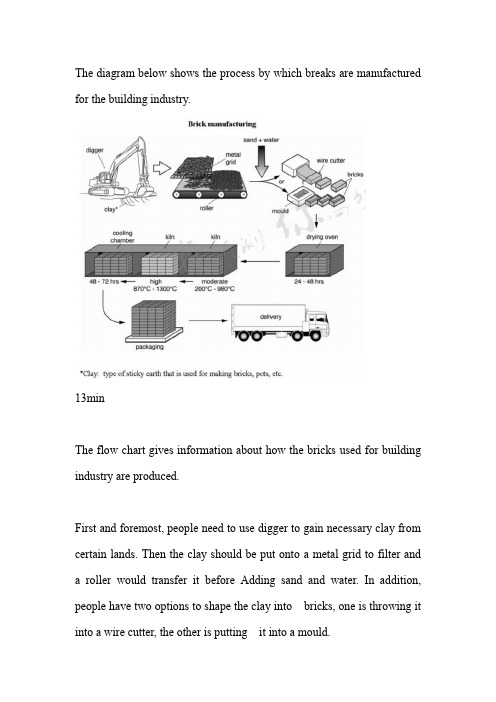
The diagram below shows the process by which breaks are manufactured for the building industry.13minThe flow chart gives information about how the bricks used for building industry are produced.First and foremost, people need to use digger to gain necessary clay from certain lands. Then the clay should be put onto a metal grid to filter and a roller would transfer it before Adding sand and water. In addition, people have two options to shape the clay into bricks, one is throwing it into a wire cutter, the other is putting it into a mould.文章第二段中所有提到的冠词需要重新处理When the bricks are molded, they will deliver to the drying oven for one or two days. In the next step, in order to heat them, producer may use the kiln to create a moderate temperature (200℃-980℃), which is followed by a high temperature(870℃-1300℃). After being heated, the bricks are going to stay in a cooling chamber for 48-72 hours.When all the steps mentioned are done, the bricks would packed and transported them to industrial sites.总评:。
雅思小作文-流程图
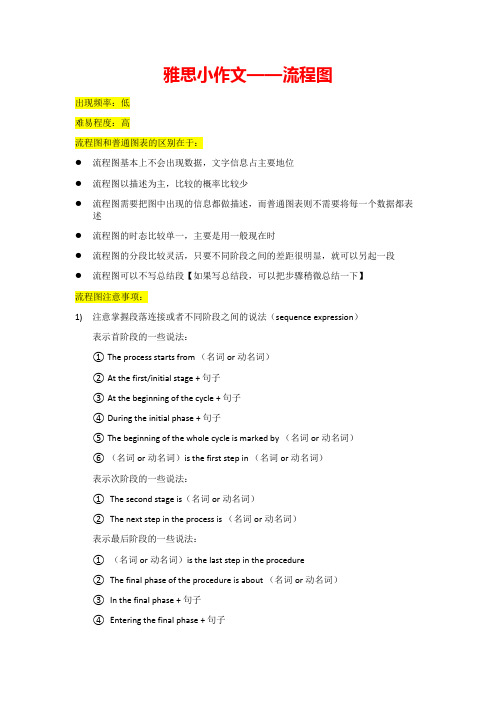
雅思小作文——流程图出现频率:低难易程度:高流程图和普通图表的区别在于:●流程图基本上不会出现数据,文字信息占主要地位●流程图以描述为主,比较的概率比较少●流程图需要把图中出现的信息都做描述,而普通图表则不需要将每一个数据都表述●流程图的时态比较单一,主要是用一般现在时●流程图的分段比较灵活,只要不同阶段之间的差距很明显,就可以另起一段●流程图可以不写总结段【如果写总结段,可以把步骤稍微总结一下】流程图注意事项:1)注意掌握段落连接或者不同阶段之间的说法(sequence expression)表示首阶段的一些说法:①The process starts from (名词or动名词)②At the first/initial stage + 句子③At the beginning of the cycle + 句子④During the initial phase + 句子⑤The beginning of the whole cycle is marked by (名词or动名词)⑥(名词or动名词)is the first step in (名词or动名词)表示次阶段的一些说法:①The second stage is(名词or动名词)②The next step in the process is (名词or动名词)表示最后阶段的一些说法:①(名词or动名词)is the last step in the procedure②The final phase of the procedure is about (名词or动名词)③In the final phase + 句子④Entering the final phase + 句子⑤(名词or动名词)is the final stage2)单词的转换主要体现在名词转换成动词。
流程图经常会出现一些器具的名词,如“grinder”“mixer”“heater”,考生需要改动成名词使用,如”ground”, “mixed”和”heated”例:The powders are delivered to the grinder, where they are ground into cement.3)注意流程图读图的顺序,很多是以循环形式出现4)除了连接词外,还可以使用分词结构和状语从句来表示顺序,如:下面几句话的意思是一样的,●Liquor butter is filtered, before being converted into solid butter.●Once liquor butter is filtered, it is converted into solid butter.●Liquor butter is filtered, until it is converted into solid matter.5)常用被动语态●误:Put these materials in the heater.●正:These materials are put in the heater.6)工序图的叙述流程图可以遵循下面的步骤:步骤1:确定材料步骤2:确定工具步骤3:确定动词,然后将这些信息写成一句话。
留学兔子 雅思考试流程图题范文

留学兔子 | 雅思考试流程图题范文作业要求:(1) 抄写所有的范文一天2篇(2) 翻译最后1篇范文(一天一篇)(3) 背诵最后两篇范文Sample Answer 1:The given diagram shows the stages of manufacturing and process adjustment of the consumer goods. As is observed from the flow chart, the goods manufacturing is a complex process which is done in several stages and information is sometimes fed back to earlier stages to make some adjustments.Firstly, raw materials and other components are stored together and production planning is done. There are two major process involves in the overall manufacturing process: one is manufacturing process itself and another one is the information feedback process with which the adjustment of the manufacturing is done. After the product research, the design part is done and this input is used in product planning stage. After the production planning is complete the assembly, inspection, testing and packaging stages are done sequentially. Feedback from testing phase is used in design stage and which led back to product planning stage. Again, the market research affects the design and advertising stages and inputs from the market research stage is used in packaging stage. The final two stages are dispatch and sales. The information flow stages gives feedback to other stages to refine and adjust the process.In summary, the consumer goods manufacturing process involves both the multi-staged manufacturing and research methods. The manufacturing stages involve the storage, assembly, inspection, packing to the sales methods whereas the research stages include market & product research, design and advertisement.The diagram below gives the information about the Hawaiian island chain in the centre of the Pacific Ocean.Write a report for a university lecturer describing the information shown.» Write at least 150 words.Sample Answer:The given illustration presents information on the Hawaiian Island Chain center of the Pacific Ocean. As is observed from the diagram, the Hawaiian island chain directly affects the Pacific tectonic plate and because of it this plate shifts around 7-9 centimeter per year.As is observed from the graph, below the Pacific Ocean, the Hawaiian island chain stands as several volcanoes which are almost 80 million years old. These volcanoes stand over the Pacific plate and the eruptions of these volcanoes’ created a new volcano just over the Magna spume. The Pacific plate is situated on solid dense rock and because of the new volcano development; the hot spot spume remained static. The eruption process of the volcano’s starts from as deep as 2800 km and that has spitted the solid rock layer.Major islands within 100 km of this area are Maui, Molokai, Oahu and Kauai and because of the eruption and sliding of the plates, the center of the Pacific Ocean is ever changing.The diagrams show a structure that is used to generate electricity from wave power.Sample Answer:The given graph shows the structure and processes of generating electricity from the wave power. As is observed from the presented illustration, the wave is used to produce the electricity and both the tide and ebb the structure is used to rotate a turbine to produce the electricity.According to the give pictorial, the electricity producing machine works in two ways. Firstly, the structure is places near a sea so that the wave water gets inside the chamber and creates an air pressure that would rotate the turbine placed inside a column. The rotation of the turbine produces electricity which is stored in the cells and this electricity can be passed and used. The whole structure is placed near the sea, adjacent to a cliff or sea wall.The second illustration depicts how the electricity can be produced using the ebb tide of the sea. During the ebb, the water gets off from the chamber and the air pressure is created again from the opposite direction and this rotates the turbine. The rotation of the turbine produces electricity and supplies it to the storage.In summary, the electricity can be produced using a structure near the sea and both the tide and ebb tide is used to rotate the turbine to produce the electricity.。
传统制砖的流程作文400字
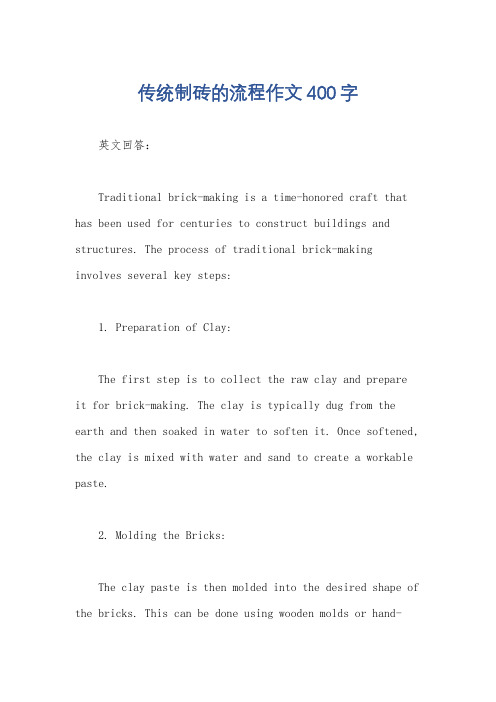
传统制砖的流程作文400字英文回答:Traditional brick-making is a time-honored craft that has been used for centuries to construct buildings and structures. The process of traditional brick-making involves several key steps:1. Preparation of Clay:The first step is to collect the raw clay and prepare it for brick-making. The clay is typically dug from the earth and then soaked in water to soften it. Once softened, the clay is mixed with water and sand to create a workable paste.2. Molding the Bricks:The clay paste is then molded into the desired shape of the bricks. This can be done using wooden molds or hand-molding techniques. The bricks are then left to dry in the sun for several days.3. Drying the Bricks:Once the bricks are dry, they are placed in a kiln for firing. The kiln is gradually heated to a high temperature, which hardens the bricks and gives them theircharacteristic red color.4. Cooling the Bricks:After firing, the bricks are allowed to cool gradually. This process is important to prevent the bricks from cracking or warping.5. Laying the Bricks:Once the bricks are cooled, they can be used for building construction. Bricks are laid in a mortar of sand, lime, and water to create strong and durable walls.中文回答:传统制砖流程。
雅思小作文流程图题型实例讲解
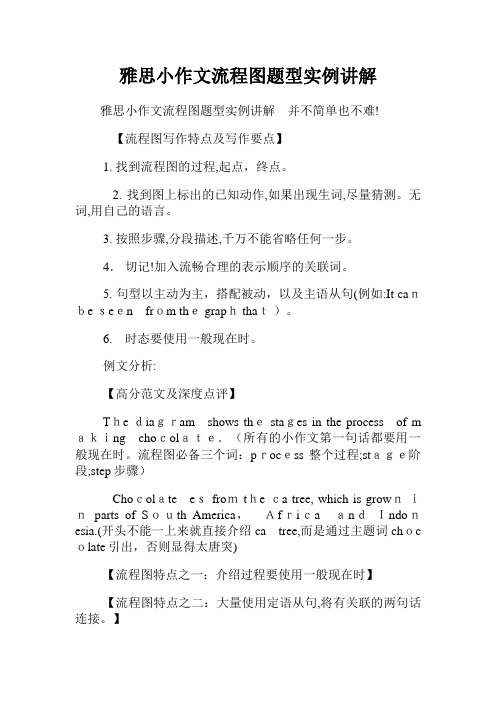
雅思小作文流程图题型实例讲解雅思小作文流程图题型实例讲解并不简单也不难!【流程图写作特点及写作要点】1. 找到流程图的过程,起点,终点。
2. 找到图上标出的已知动作,如果出现生词,尽量猜测。
无词,用自己的语言。
3. 按照步骤,分段描述,千万不能省略任何一步。
4.切记!加入流畅合理的表示顺序的关联词。
5. 句型以主动为主,搭配被动,以及主语从句(例如:It canbe seen from the graph that)。
6.时态要使用一般现在时。
例文分析:【高分范文及深度点评】The diagram shows the stages in the process of m aking chocolate.(所有的小作文第一句话都要用一般现在时。
流程图必备三个词:process整个过程;stage阶段;step步骤)Chocolate es from the ca tree, which is growninparts of South America,AfricaandIndonesia.(开头不能一上来就直接介绍ca tree,而是通过主题词choc olate引出,否则显得太唐突)【流程图特点之一:介绍过程要使用一般现在时】【流程图特点之二:大量使用定语从句,将有关联的两句话连接。
】【流程图特点之三:大量使用被动语态】The tree pro duces largered ds which contain whitecocoa beans.【流程图特点之四:使用一些表示顺序的连接词】whe nthe ds are ripe,they are harvested,the beans are r eved and they are fermented for several days in l argewoodenboxes.(三个句子的并列:句子A,句子B and 句子C 。
)Duringthe fermentingprocess, the beansturn brown.【流程图特点之五:要适当地添加个别图中没有交代但能从图片中直接读出来的一些内容,否则可能达不到字数要求。
雅思小作文流程图英文

雅思小作文流程图英文Alright, here's an example of a descriptive IELTS-style diagram essay in English, following the given requirements:Okay, let's break down this process step by step. First things first, you start with a blank canvas. Then, you select your colors and brushes. It's like choosing the ingredients for a meal, you know? Once you've got that,it's all about layering. You start with the base colors, building up the foundation.Next up, comes the detailing. It's like adding the spices and herbs to your dish. You go in with precision, adding highlights and shadows, making sure everything is just right. And don't forget, just like in cooking, sometimes you need to step back and take a look at the big picture. Adjustments are key.After that, comes the finishing touches. It's like adding the garnish to your meal. You might add a few extrastrokes, a bit of gloss or maybe even some texture. It'sall about making it perfect.Finally, you stand back and admire your work. Just like when you serve up a delicious meal, you take a moment to appreciate the beauty of what you've created. And remember, every painting is unique, just like every meal. So, enjoy the process and let your creativity shine!Note that each paragraph is written independently, focusing on a different aspect of the process, while maintaining a conversational tone and avoiding any formal introductions or transitions.。
雅思小作文流程图9分

雅思小作文流程图9分## Mastering the IELTS Process Diagram: A Journey to Band 9 The IELTS Academic Writing Task 1 presents a unique challenge: transforming visual information into a coherent and concise piece of writing. Among the various formats, the process diagram stands out for its intricate portrayal of sequential steps, often leaving test-takers overwhelmed. However, with a strategic approach and diligent practice, achieving a band 9 score in this task becomes an attainable goal. Let's embark on a journey to unravel the secrets of mastering the IELTS process diagram, exploring key strategies and insights that will empower you to excel. Before delving into the intricacies of writing, it's crucial to understand the essence of a process diagram. Unlike static charts or maps, a process diagram illustrates a sequence of actions, often involving transformations, decisions, or stages leading to a final outcome. This dynamic nature demands a writing stylethat captures not only the individual steps but also the flow and interconnectedness between them. Think of it as narrating a story of transformation, guiding the reader through the journey from the initial input to the ultimate result. Your journey to a band 9 score begins with a meticulous analysis of the diagram. Take a moment to observe the starting point, the ending point, and the various steps in between. Identify the key elements involved, including materials, actions, and decision points. Pay close attention to any arrows, labels, or symbols that indicate the direction and nature of the process. This initial observation forms the foundation for your writing, ensuring that you capture all the essential details. With a clear understanding of the process,it's time to craft an introduction that sets the stage for your description. Briefly paraphrase the diagram's title to convey the overall theme or process being depicted. For instance, instead of simply stating "The process of making cheese," you might write, "The diagram illustrates the intricate steps involved in transforming milk into cheese." This approach demonstrates your ability to synthesize information and use synonyms effectively, both of which are highly valued in the IELTS assessment. The main body paragraphs form the heart of your response, where you meticulously describe each stage of the process. Employ a logical flow, typically following the chronological sequence presented in thediagram. Use a variety of transition words and phrases to connect the steps, indicating the progression and relationships between them. For example, you might use words like "initially," "subsequently," "following this," or "as a result" to create a smooth and coherent narrative. While describing each step, focus on the key actions or transformations taking place. Use active voice and precise vocabulary to convey the dynamics of the process. For instance, instead of simply stating "the milk is heated," you might write, "the milk is gradually heated to a specific temperature." This level of detail demonstrates your command of the language and your ability to express nuances effectively. As you progress through the description, be sure to highlight any decision points or alternative pathways within the process. Explain the conditions that lead to different outcomes and the consequences of each choice. This demonstrates your understanding of the complexities involved and your ability to analyze the information critically. Finally, conclude your response with a concise summary of the entire process, reiterating the key stages and the final outcome. You might also mention the significance or purpose of the process, providing a broader context for your description. This concluding paragraph showcases your ability to synthesize information and provide a holistic perspective. Remember, the key to achieving a band 9 score lies not only in accurately describing the process but also in demonstrating a high level of language proficiency and critical thinking. Use a variety of sentence structures, vocabulary, and grammatical constructions to showcase your linguistic dexterity. Analyze the information presented in the diagram and provide insights beyond a mere description of the steps. By combining meticulous observation, clear organization, and sophisticated language use, you can confidently approach the IELTS process diagram and unlock the door to a band 9 score.。
英语雅思流程图范文
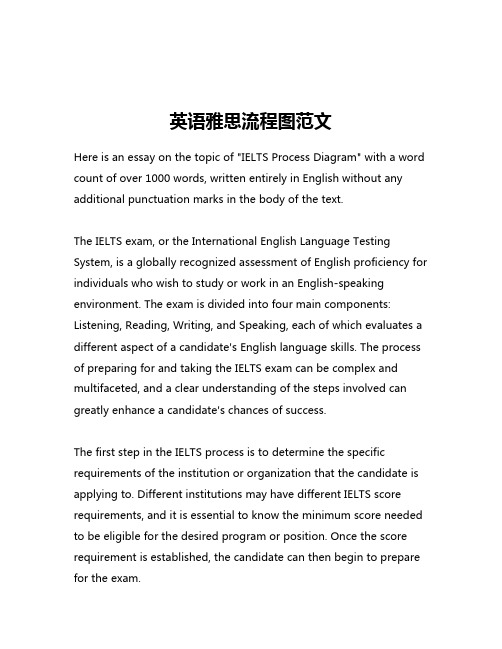
英语雅思流程图范文Here is an essay on the topic of "IELTS Process Diagram" with a word count of over 1000 words, written entirely in English without any additional punctuation marks in the body of the text.The IELTS exam, or the International English Language Testing System, is a globally recognized assessment of English proficiency for individuals who wish to study or work in an English-speaking environment. The exam is divided into four main components: Listening, Reading, Writing, and Speaking, each of which evaluates a different aspect of a candidate's English language skills. The process of preparing for and taking the IELTS exam can be complex and multifaceted, and a clear understanding of the steps involved can greatly enhance a candidate's chances of success.The first step in the IELTS process is to determine the specific requirements of the institution or organization that the candidate is applying to. Different institutions may have different IELTS score requirements, and it is essential to know the minimum score needed to be eligible for the desired program or position. Once the score requirement is established, the candidate can then begin to prepare for the exam.The preparation phase is a crucial aspect of the IELTS process. Candidates should familiarize themselves with the exam format and the types of questions they can expect to encounter in each section. This can be achieved through extensive practice using IELTS practice materials, such as sample tests and online resources. Additionally, candidates may choose to enroll in IELTS preparation courses or work with a private tutor to receive personalized guidance and feedback on their language skills.During the preparation phase, candidates should also work on improving their English proficiency in all four language domains: listening, reading, writing, and speaking. This may involve regular practice in each area, as well as targeted study of grammar, vocabulary, and common idioms and expressions used in the IELTS exam.Once the candidate feels adequately prepared, the next step is to register for the IELTS exam. This can be done through the official IELTS website or by contacting an authorized IELTS test center. Candidates will need to provide personal information, such as their name, date of birth, and contact details, as well as the desired test date and location.On the day of the exam, candidates should arrive at the test centerwell-rested and ready to demonstrate their English language skills. The IELTS exam is divided into four separate sections, each with its own specific format and time allocation.The Listening section of the IELTS exam typically lasts for approximately 30 minutes and consists of four recorded audio passages, each followed by a series of questions. Candidates must listen carefully and provide written answers to the questions.The Reading section of the IELTS exam is designed to assess the candidate's ability to understand and comprehend written English. This section consists of three passages, each followed by a series of questions. Candidates have 60 minutes to complete the Reading section.The Writing section of the IELTS exam is divided into two tasks. Task1 requires candidates to analyze and describe a given visual, such asa graph, chart, or diagram, in a written response. Task 2 involves writing a discursive essay on a given topic. Candidates have a total of 60 minutes to complete both writing tasks.The final section of the IELTS exam is the Speaking section, which is conducted one-on-one with an IELTS examiner. This section is designed to assess the candidate's ability to communicate effectively in English, and it consists of three parts: an introduction andinterview, a long turn where the candidate must speak for 2 minutes on a given topic, and a discussion on the same topic. The Speaking section typically lasts for 11-14 minutes.After completing the IELTS exam, candidates will receive their results within 13 calendar days for paper-based tests or 3-5 calendar days for computer-delivered tests. The results are reported on a band scale from 1 to 9, with 9 being the highest level of English proficiency. Candidates can then use their IELTS scores to apply for their desired program or position.It is important to note that the IELTS process does not end with the exam itself. Candidates may need to retake the exam if they do not achieve the required score, or they may need to continue to improve their English language skills in preparation for a future IELTS test. Additionally, some institutions or organizations may require candidates to maintain their IELTS scores for a certain period, and candidates may need to retake the exam to renew their scores.In conclusion, the IELTS process is a multifaceted and complex journey that requires careful planning, preparation, and execution. By understanding the various steps involved, candidates can better navigate the IELTS process and increase their chances of success in achieving their desired IELTS score and reaching their academic or professional goals.。
雅思流程图范文《砖块的制作》(含9分范文及考官点评)
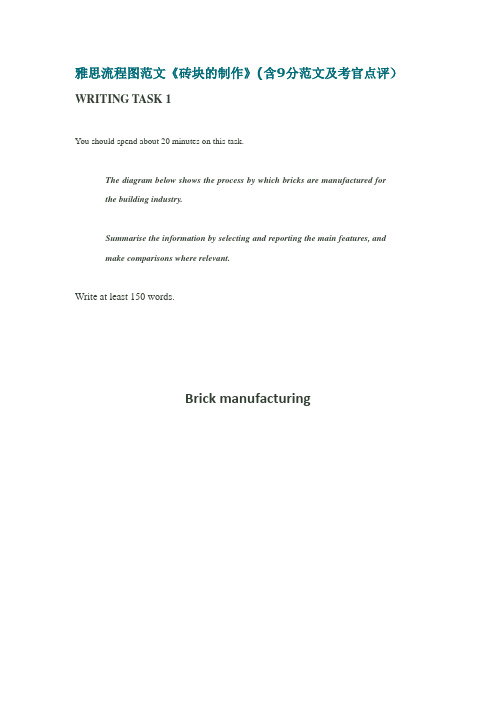
雅思流程图范文《砖块的制作》(含9分范文及考官点评)WRITING TASK 1You should spend about 20 minutes on this task.The diagram below shows the process by which bricks are manufactured forthe building industry.Summarise the information by selecting and reporting the main features, andmake comparisons where relevant.Write at least 150 words.Brick manufacturing*Clay: type of sticky earth that is used for making bricks, pots, etc.【满分范文】The process by which bricks are manufactured for the building industry can be outlined in seven consecutive steps. First the raw material, clay, which was just below the surface of soil in certain clay-rich areas has to be dug up by a digger.Then the lumps of clay are placed on a metal grid in order to break up the big chunks of clay into much smaller areas, which fall through the metal grid onto a roller, whose motion further segregates the bits of clay. Sand and water are added to make a homogenous mixture, which is then either formed in moulds or cut into brick-shapedpieces by means of a wire cutter.Those fresh bricks are then kept in a drying oven for at least 24 and a maximum of 48 hours, several dozens if not hundreds of bricks at a time. The dried bricks are then transferred to a so-called kiln, another type of high temperature oven. First they are kept at a moderate temperature of 200℃-1300℃. This process is followed by cooling down the finished bricks for 48 to 72 hours in a cooling chamber.Once the bricks have cooled down and have become hard, they get packaged and delivered to their final destination, be it a building site or storage.(215 words)【考官评语】Band 9This response fully satisfies the requirements of the task. All key features of each stage of the process are appropriately and accurately presented. An excellent overview is given at the beginning of the response and this skilfully incorporates part of the rubric, changing the grammatical function, to give a brief summary of the whole process. The message is very easy to read, with seamless cohesion that attracts no attention. Paragraphing, linking and referencing are all skilfully managed. The language used is very fluent and sophisticated. A wide range of vocabulary and structures are used with full flexibility and accuracy. Only rare minor ‘slips’ can be found and these do not detract from the high rating.。
雅思小作文范文-流程图
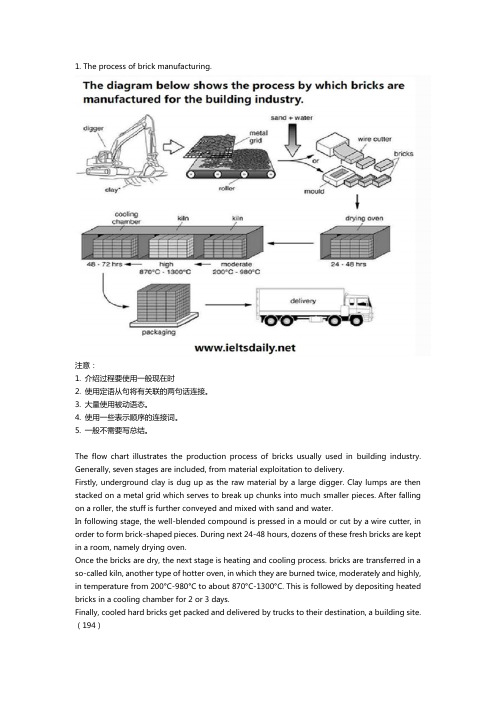
1. The process of brick manufacturing.注意:1. 介绍过程要使用一般现在时2. 使用定语从句将有关联的两句话连接。
3. 大量使用被动语态。
4. 使用一些表示顺序的连接词。
5. 一般不需要写总结。
The flow chart illustrates the production process of bricks usually used in building industry. Generally, seven stages are included, from material exploitation to delivery.Firstly, underground clay is dug up as the raw material by a large digger. Clay lumps are then stacked on a metal grid which serves to break up chunks into much smaller pieces. After falling on a roller, the stuff is further conveyed and mixed with sand and water.In following stage, the well-blended compound is pressed in a mould or cut by a wire cutter, in order to form brick-shaped pieces. During next 24-48 hours, dozens of these fresh bricks are kept in a room, namely drying oven.Once the bricks are dry, the next stage is heating and cooling process. bricks are transferred in a so-called kiln, another type of hotter oven, in which they are burned twice, moderately and highly, in temperature from 200°C-980°C to about 870°C-1300°C. This is followed by depositing heated bricks in a cooling chamber for 2 or 3 days.Finally, cooled hard bricks get packed and delivered by trucks to their destination, a building site.(194)2. The production of steam using a gas cooled nuclear reactor.1. 看懂基本过程和原理,定位流程的起点和终点。
- 1、下载文档前请自行甄别文档内容的完整性,平台不提供额外的编辑、内容补充、找答案等附加服务。
- 2、"仅部分预览"的文档,不可在线预览部分如存在完整性等问题,可反馈申请退款(可完整预览的文档不适用该条件!)。
- 3、如文档侵犯您的权益,请联系客服反馈,我们会尽快为您处理(人工客服工作时间:9:00-18:30)。
英语考试作文
9分雅思图表写作范文全集之流程图砖块
制造流程
9分雅思范文之流程图砖块制造流程The diagram below shows the process by which bricks are manufactured for the building industry.
范文集结:全部15篇9分雅思流程图范文汇总放送
参考发文
The process diagram illustrates the steps involved in the production of bricks that are normally utilized in constructing various structures like houses and buildings. The entire process mainly consists of four different steps.
First of all, the soft clay is dug from the ground with the help of a manually operated digger. This clay is then sifted through a metal grid onto a roller to get rid of rocks and debris. After that, water and sand is mixed with clay, and bricks are formed by placing the mixture in molds or by cutting them with a wire cutter. Next, the bricks are dried in an oven
for 24-48 hours, before baking them in a kiln, first at moderate temperature of 200-980C followed by extremely high temperature of 870-1300C. They are further cooled for 48-72 hours in the cooling chamber, and are later packed and loaded in trucks, thus, preparing them for delivery to different places.
Total Words: 155
Task Achievement: 9
Coherence & Cohesion: 9
Lexical resources: 9
Grammar: 9
Overall Score: Band 9。
